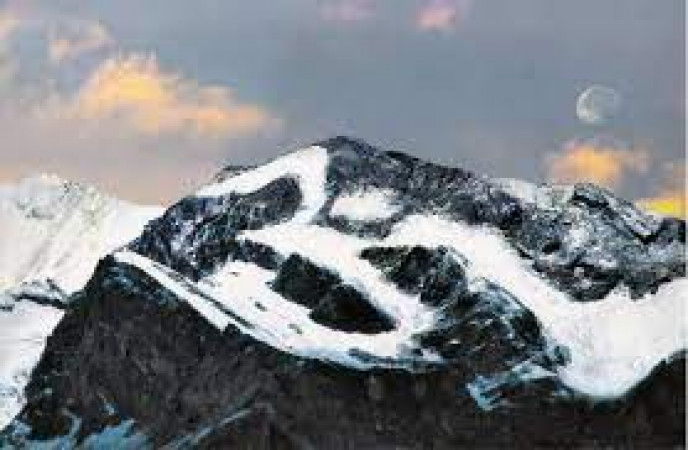
Om Parvat
Duration
2 to 4 Days
2 to 4 Days
Best time to visit
May-Aug
May-Aug
Theme
Religious, Hill Station
Religious, Hill Station
Om Parvat Travel Guide
Om Parvat, located in the Indian Himalayas, is a sacred mountain known for its religious significance and unique natural beauty. This majestic peak is famous for the natural formation resembling the revered Hindu symbol 'Om', attracting pilgrims and trekkers alike. With its rich history and breathtaking views, Om Parvat offers a spiritual and adventurous experience like no other.Top Attractions in Om Parvat
- Om Parvat Summit
- Adi Kailash Trek
- Jolingkong Lake
- Parvati Tal
- Om Parvat Yatra
Om Parvat is Famous for
The **unique natural formation** resembling the sacred symbol 'Om' is what Om Parvat is most renowned for.Top Attractions in Om Parvat
- Experience the awe-inspiring Om Parvat Summit
- Trek to Adi Kailash, the heavenly abode of Lord Shiva
- Visit the tranquil Jolingkong Lake
- Explore the mystical Parvati Tal
- Embark on the spiritual Om Parvat Yatra
What's Great about Travelling to Om Parvat?
- **Spiritual Experience:** Perfect for pilgrims and spiritual seekers
- **Adventure:** Offers thrilling treks and stunning landscapes
- **Peaceful Environment:** Ideal for those seeking tranquility
What's Not So Great about Travelling Om Parvat?
- **Harsh Weather:** Extreme cold temperatures can be challenging
- **Limited Facilities:** Basic amenities may not be easily available
- **Altitude Sickness:** Risk of altitude-related health issues
Travel Tips for Om Parvat
- **Visa Requirements:** Check visa regulations for traveling to India
- **Transportation:** Hire a local guide for trekking and transportation
- **Safety:** Acclimatize properly to avoid altitude sickness
Important Om Parvat trip information
- Ideal Duration: 7-10 days for a comprehensive experience
- Best Time to Visit: May to June and September to October
- Nearby Airports and Railway Stations: The nearest airport is Dehradun Airport, and the closest railway station is Tanakpur Railway Station
FAQ's on Om Parvat
Q1: What is the best time to visit Om Parvat?
The best time to visit Om Parvat is during the summer months from April to June and the autumn months of September to November. During these periods, the weather is pleasant, and the skies are clear, offering stunning views of the mountain. Avoid visiting during the monsoon season from July to August due to heavy rainfall which can make trekking difficult. Winter months from December to February are also not recommended due to extreme cold and snowfall.
Q2: Do I need a visa to travel to Om Parvat?
Tourists visiting Om Parvat typically require a tourist visa. However, certain nationalities may be eligible for visa on arrival or visa-free entry. It is advisable to check with the respective embassy or consulate for the most up-to-date visa requirements before traveling.
Q3: What are the must-visit attractions in Om Parvat?
The must-visit attractions in Om Parvat include the sacred Om Parvat peak itself, which is revered by pilgrims, as well as the nearby Kailash Mansarovar Lake. Other attractions include Tawaghat and Gunji villages, known for their scenic beauty and cultural significance. Trekking routes in the region offer breathtaking views of the Himalayas and opportunities for nature enthusiasts.
Q4: Is Om Parvat a safe place to travel?
Om Parvat is generally safe for travelers. However, as with any remote mountainous region, it is essential to take necessary precautions and be prepared for the challenging terrain. It is advisable to trek with a guide or in a group, especially for those not familiar with the area. Always stay informed about weather conditions and follow safety guidelines provided by local authorities.
Q5: What is the local currency in Om Parvat and can I use credit cards?
The local currency in Om Parvat is the Indian Rupee (INR). While credit cards may be accepted in some hotels or larger establishments, it is advisable to carry cash, especially in remote areas. ATMs may be limited, so it is recommended to withdraw sufficient cash in major towns before heading to more rural locations.
Q6: What is the local cuisine like in Om Parvat?
The local cuisine in Om Parvat is influenced by Himalayan flavors and consists of dishes like Thukpa (noodle soup), Momos (dumplings), and locally grown grains and vegetables. Due to the high altitude, food may be simple but hearty, often incorporating dairy products like Yak cheese. Travelers with dietary restrictions should inform their accommodations in advance to ensure suitable meal options.
Q7: What transportation options are available in Om Parvat?
Transportation options in Om Parvat include local buses, shared jeeps, and private taxis for getting around the region. Trekking is a popular way to explore the area, with various trails leading to different attractions. For those seeking more comfort, private tours and rental cars with drivers can be arranged in nearby towns. It is essential to plan transportation in advance, especially for remote destinations.
Q8: Are there any cultural norms or etiquette I should be aware of when visiting Om Parvat?
When visiting Om Parvat, it is important to respect local customs and traditions. Dress modestly, especially when visiting religious sites, and remove shoes before entering temples or homes. Greeting locals with a "Namaste" is appreciated, and always ask for permission before taking photographs of people. Avoid public displays of affection and be mindful of environmental conservation by not littering or disturbing wildlife. Embrace the unique culture of the region with an open mind and a spirit of curiosity.
Q9: I am a travel agent. How can I buy travel leads of Om Parvat?
Register yourself as a travel agent at agents.tripclap.com and then you can buy travel leads to Om Parvat once your account is approved. For more details contact our support team at +91-8069186564 or support@tripclap.com
